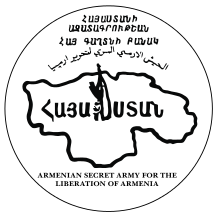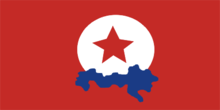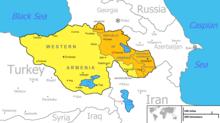Armenian Secret Army for the Liberation of Armenia

The Armenian Secret Army for the Liberation of Armenia (Armenian Հայաստանի Ազատագրութեան Հայ Գաղտնի Բանակ, ՀԱՀԳԲ Hayasdani Azadakrut'ean Hay Kaghtni Panag, HAHKP, Armenian Secret Army for the Liberation of Armenia in English), or Asala, was an underground Marxist-Leninist organization that operated from 1975 until the early 1990s. While the Asala was classified by itself and other sources as a guerrilla, other authors, the State Departments of Azerbaijan and the United States, as well as the Turkish Ministry of Culture, have listed it as terrorist and armed.
As a result of 84 documented attacks by the Asala, 46 people were killed and 299 wounded. The intention of the Asala was to "force the Turkish government to admit its responsibility for the Armenian genocide beginning in 1915, the payment of reparations and territorial cessions to the Armenian homeland". The main goal of the Asala was to re-establish historic Armenia, which in their view included Western Armenia and Soviet Armenia. The claimed territory corresponded to that promised to Armenians in 1920 by US President Woodrow Wilson in the unratified Treaty of Sèvres (Wilsonian Armenia). Instead, the border between Turkey and the Soviet Union was established in the Treaty of Kars on 13 October 1921 and ratified in Yerevan on 11 September 1922.
The leader of the group from 1975 to 1988 was Hagop Agopjan; other important members were Hagop Tarakjijan, Ara Yenikomoushian and Monte Melkonian (died during the war in Nagorno-Karabakh in June 1993). The group was allied with the Palestine Liberation Organization (PLO) and, since the 1980s, the Kurdistan Workers' Party (PKK), and received clandestine support from the Armenian diaspora in Europe and the United States. Suffering from internal strife, the group became relatively inactive in the 1990s, although it claimed credit for a failed assassination attempt on the Turkish ambassador to Hungary in 1991. The organization did not engage in any military activities since then. Its motto was "Long live the revolutionary solidarity of the oppressed peoples!" and "The armed struggle and the right political line are the way to Armenia."

The flag of the Asala

The territory claimed by the Asala.
Background
The survivors of the massacres of the Armenian population in the Ottoman Empire in 1915 found refuge in countries of the Middle East, Western Europe as well as in the United States. Ringleaders and key figures of the genocide were murdered in the 1920s by Armenians such as Soghomon Tehlirian (Operation Nemesis). However, the successor to the Ottoman Empire, the Republic of Turkey, continued to maintain that the events of 1915 were not genocide; on the contrary, the Turkish state campaigned against any attempts to bring these events to light and prevented recognition in the West. In fact, the government claimed that Armenians had instigated violence and accused the empire's Armenian minority of allegedly massacring hundreds of Turks, which was the cause of the deportation of the entire Armenian civilian population. In 1965, Armenians around the world commemorated the 50th anniversary of the genocide and began to push for worldwide recognition of the unaddressed genocide. When peaceful marches and demonstrations were ignored by intransigent Turkey, the younger generation of Armenians - due to Turkey's denial and the failure of their parents' generation to effect change - sought newer approaches to gain recognition and reparations. In 1973, two Turkish diplomats, Consul General Mehmet Baydar and Consul Bahadır Demir, were assassinated in Los Angeles by a genocide survivor, Kurken Yanikian. This event could have been gradually forgotten had it not initiated a chain of incidents that transformed the event and its perpetrator into a symbol representing the end of the conspiracy of silence that had surrounded the ArmenianGenocide since 1915.
Foundation and beginnings
The Asala was founded on January 20, 1975, at the beginning of the Lebanese Civil War by members of the Armenian diaspora in Lebanon's capital Beirut, where there was a strong Armenian community of genocide descendants, especially in the suburb of Bourj Hammoud. Key founding members included Hagop Agopjan (real name Harutiun Tokashian) and Hagop Tarakjian, and possibly the writer Kevork Ajemian. In the beginning, the Asala bore the name "Group of the Captive Kurk Yanikian". It consisted mainly of diaspora Armenians born in Lebanon whose parents and/or grandparents were survivors of the Armenian Genocide. The organization followed a theoretical model based on leftist ideology. The Asala was critical of its predecessors and the diaspora parties, accusing them of not understanding how to deal with the problems of the Armenian people. The head of the structural group was the General Command of the People of Armenia (VAN).
The group's activities consisted mainly of assassinating Turkish diplomats and politicians in Western Europe, the United States and the Middle East. Their first recognized assassination was the killing of Turkish diplomat Daniş Tunalıgil in Vienna on October 22, 1975. A failed attack in Geneva on October 3, 1980, in which two Armenian militiamen were killed, led to a new nickname for the group, the October 3 Organization. The Asala's eight-point manifesto was published in 1981.
The Asala, trained in the Beirut camps of the Palestine Liberation Organization (PLO), is the best-known guerrilla group responsible for the murder of at least 36 Turkish diplomats. Since 1975, a dozen Turkish diplomats or family members of politicians have been targeted in attacks - with the result that Armenian revenge, as well as the background of the Armenian liberation struggle, made it through the world press. These noteworthy attacks were successful in denouncing the genocide and its silence before the international public, although they were carried out by a very small group.
Questions and Answers
Q: What was the name of the terrorist organization?
A: The Armenian Secret Army for the Liberation of Armenia (ASALA).
Q: When did ASALA operate?
A: ASALA operated from 1975 to 1986.
Q: Who founded ASALA?
A: Hagop Hagopian (Harutiun Tagushian) and Kevork Ajemian, a prominent contemporary writer, founded ASALA in 1975 in Beirut, Lebanon.
Q: What were some of the activities carried out by ASALA?
A: The group's activities were primarily assassinations of Turkish diplomats and politicians in Western Europe, the United States and the Middle East.
Q: What was the nickname given to ASALA after an attack in Geneva on October 3rd 1980?
A: After a failed attack in Geneva on October 3rd 1980 which resulted in two Armenian militants being injured, a new nickname for the group was given - The 3 October Organization.
Q: What did ASALAs eight point manifesto state?
A: The eight point manifesto stated that they wanted Turkey to acknowledge publicly its alleged responsibility for deaths of 1.5 million Armenians in 1915, pay reparations and cede territory for an Armenian homeland.
Q: How did Turkey respond to attacks by ASALAs?
A: Turkey accused Cyprus, Greece, Syria, Lebanon and Soviet Union of provoking or possibly funding the ASALa though nothing was ever found to be true. Additionally Turkish officials frequently used accusation of collaboration with Asala and foreign Armenian circles to incriminate extreme left-wing Turkish opposition groups.
Search within the encyclopedia